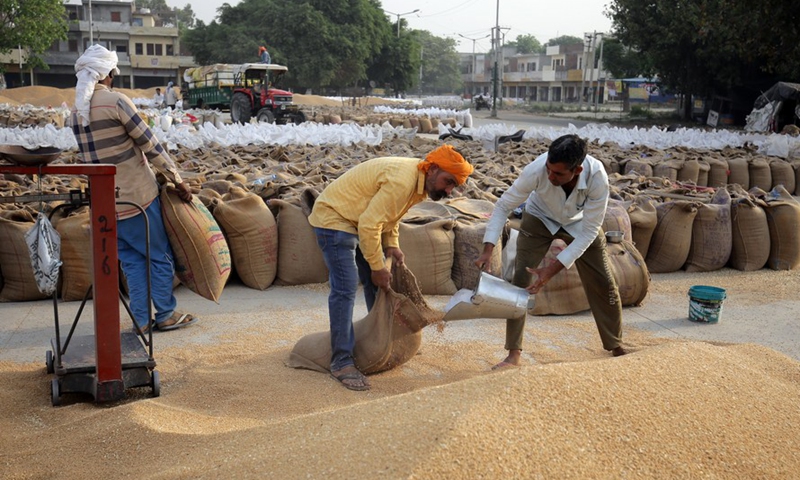
Workers fill bags with wheat at a market in Amritsar district of India's northern Punjab state, April 19, 2022.Photo:Xinhua
India's abrupt move to ban wheat exports after the volume hit a record high in April is expected to slightly push up international wheat prices, but its impact on China's domestic supply will be limited due to sufficient inventory, Chinese experts said on Sunday.India's Ministry of Commerce and Industry banned the export of wheat by putting the grain under the "prohibited" category on Friday. According to a notification released by the government, which said that the move was to "manage overall food security of the country and to support the needs of the neighboring and other vulnerable nations."
Exports will be allowed on the basis of permission granted by the Indian government to other countries to meet their food security needs and based on the requests of their governments, it said.
Jiao Shanwei, editor-in-chief of industry news website cngrain.com, attributed India's move to lower wheat output caused by extreme heat in the country that has persisted for weeks, while India's export spikes since the start of the Russia-Ukraine conflict have pushed domestic food prices higher.
On May 4, India's food ministry cut its estimate for wheat output this season to 105 million tons, down from a record 111.32 million tons forecast previously and 109.6 million tons produced a year earlier.
According to official data, the average price of wheat flour in retail markets in India was about 33 rupees ($0.43) per kilogram on May 8, up nearly 13 percent from a year earlier, Indian media out the Economic Times reported.
India's export curb may lead to slight, short-term increases in international wheat prices, but the impact will be very limited since it's not a major wheat exporter, Jiao told the Global Times on Sunday.
With output at about 110 million tons in 2021, India is the third-largest wheat grower behind China with about 137 million tons and the EU with about 150 million tons, but it's the eighth-largest exporter following countries like the US, Canada, Russia and Ukraine, Ma Wenfeng, a senior analyst at the Beijing Orient Agribusiness Consultancy, told the Global Times on Sunday.
As logistics in Russia and Ukraine have been disrupted, India's wheat exports have been making up for the contraction in exports, Ma said. India's move is expected to make ripples in the market only in the short term, he said, noting that many countries started to increase grain production last year as international prices surged.
China's inventory of food like wheat, soybeans and corn remains high, supporting the country in coping with any external risks.
"China's wheat inventory is at a historically high level, which can meet domestic demand for more than a year," Sun Heng, a wheat analyst at the National Grain and Oil Information Center, told the Global Times in a recent interview.
Sun noted that China's wheat is fully self-sufficient, and allowing for a small percentage of wheat imports is mainly for variety adjustment to meet the improvement of people's living standards.
Amid challenges brought about Omicron flare-ups and rising geopolitical uncertainties, the Chinese government has vowed all necessary efforts to ensure the supply of food such as wheat and corn, and provide sufficient fertilizers so that farmers could expand agricultural output and increase grain storage.
According to data from China's Ministry of Agriculture and Rural Affairs on Thursday, the country's spring ploughing was 72.4 percent complete, 1.8 percentage points faster than the same period last year, with planting of spring wheat finishing nearly 90 percent.



